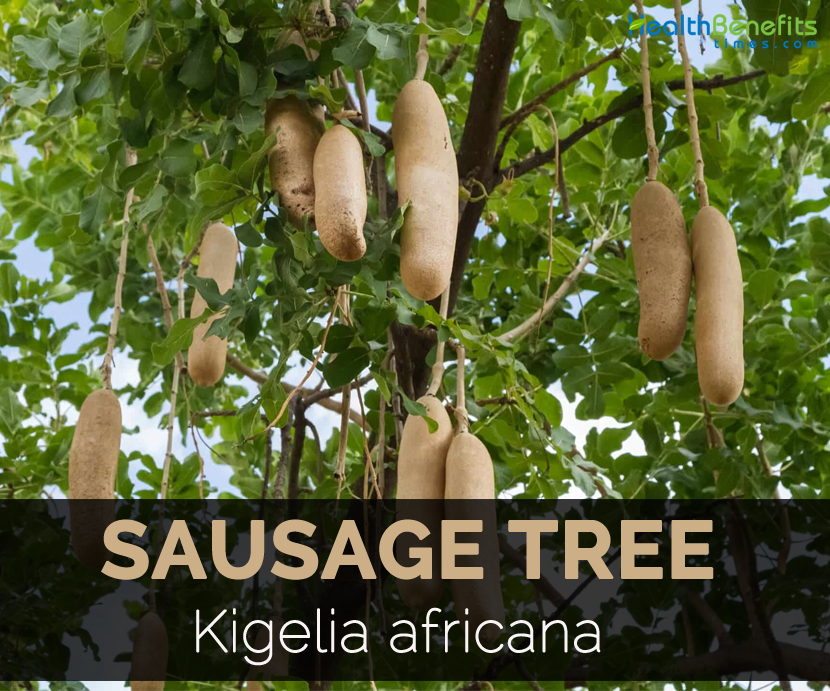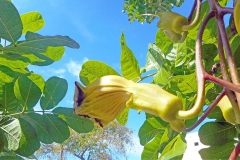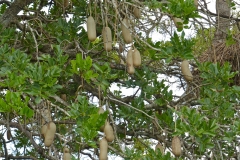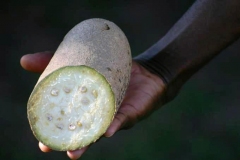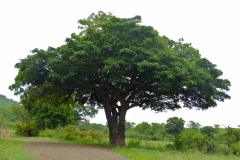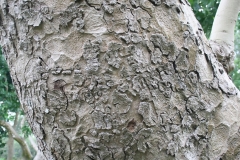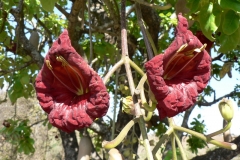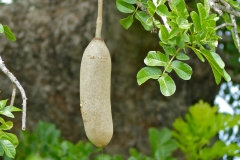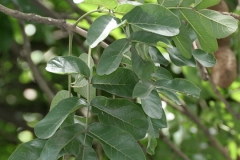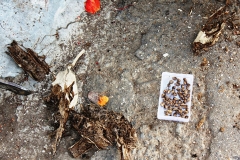Plant description
Kigelia Africana is a deciduous and wide spreading tree which reaches 10 to 20 meters high having short and squat light brown trunk and bark which is flaky as it ages. Leaves are alternate, odd pinnate having 5 to 9 leaflets which are opposite, glossy and ovate to elliptic-ovate measuring 8–16 cm long by 3–6 cm wide. Flowers are large, maroon red upto 9 cm wide and borne in 4 to 12 flowered panicles on long and pendulous pedicles. Calyx is campanulate, 5-toothed or lobed. Corolla tube is slender, broadly bell shaped, curved and 5-lobed. Flowers are then followed by fruits which is hard, greyish-brown, huge, scurfy, oblong or oblong-cylindric about 20–100 cm in length, 8–18 cm wide. The pulp is firm and fibrous which contains numerous small seeds. It weighs 5-10 kg.
Leaves are opposite or in whorls of three about 30 to 51 cm long, pinnate having 6 to 10 leaflets upto 20 cm long and 5.7 cm broad. The terminal leaflet can be present or absent.
Flowers
Flowers hang down from branches on long and flexible stems. Flowers form in panicles. Flowers are bell shaped, orange to maroon or purplish green and about 10 cm (4 inches) wide.
Fruit
Fruit is a woody berry about 30 to 99 cm and 18 cm broad. It weighs between 5 to 10 kg. The pulp of the fruit is fibrous and contains many seeds.
Traditional uses
- It is used by traditional healers for treating skin ailments, boils, fungal infections, eczema, psoriasis and ringworm.
- Use it for internal ailments such as tape worm, dysentery, diabetes, malaria, haemorrhaging, toothache, pneumonia and used as a purgative.
- The fruit is used as a wash or drink for young children in Southern Nigeria.
- Dried root bark is used for treating uterus cancer and alimentary tract cancer in Malawi.
- In Gold Coast, the bark is used as a cure for dysentery and rheumatism.
- In Sierra Leone, women apply heated bark to breast for speeding up returning to normal after suckling child has been detached.
- In Tanzania, bark is used for treating swelling of breasts.
- Fruit decoction is used as an aid for oedema of legs and elephantiasis in Cote D’Ivorie.
- In Central Africa, unripe fruit is used as dressing for rheumatism and syphilis.
- Women apply cosmetic preparations of Kigelia Africana fruit for a blemish free complexion.
- Use the green fruit as a poultice for rheumatism and syphilis and apply the poultice made from leaves for treating backache.
- For toothache, decoction made form bark is used to gargle in Zimbabwe.
- To treat epilepsy, wash the head with bark infusion.
- Leaves are used or treating stomach, kidney ailments, dysentery and wounds in West Africa.
- Use the fruit to treat acne.
- Bark is used for dysentery and rheumatism in the Gold Coast.
Culinary uses
- Fruits are dried, fermented or roasted.
- Roasted fruits are used to flavor beer.
- Roasted seeds are consumed as famine food.
Other facts
- Dried fruits are used to make an alcoholic beverage called Muratina which is a core component in cultural events in Central Kenya.
- Kigelia is also used in a number of skin care products.
- Timber is used for makoros, yokes and oars in Botswana.
- Tree is widely grown as an ornamental tree in tropical regions for its decorative flowers and unusual fruit.
- Slices of mature baked fruits are used to ferment and flavor traditional African beer.
- Boiled fruits are also used to produce a red dye and the roots are reported to produce a yellow dye.
- Wood is considered excellent for dugout canoes, planks and fence-posts.
- It is also used for making boxes, drums, stools, yokes, tool handles, mortars and large bowls for watering cattle.
- Weapon bows are made from branches, and smaller branches are hollowed to administer enemas to children.
- Due to its occurrence along watercourses, it is suitable for erosion control and riverbank stabilization.
- All parts of the tree are used in traditional medicine for a number of illnesses ranging from blood and circulatory system disorders to digestion and infection problems.
- The tree begins to flower at the age of 6 years.
Side Effects
- Unripe fruit is reputed to be highly poisonous if taken orally.
- Fruit sometimes causes blistering of the tongue and skin.
- It has also been alleged that a woman died 36 hours after vomiting when this plant was used as an abortifacient.
- Do not eat fresh or green fruits.
References:
https://www.itis.gov/servlet/SingleRpt/SingleRpt?search_topic=TSN&search_value=506043#null
https://www.researchgate.net/publication/242739648_Kigelia_africana_Lam_Benth_-_An_overview
https://en.wikipedia.org/wiki/Kigelia
http://www.stuartxchange.org/AfricanSausageTree.html
Comments
| Sausage Tree Quick Facts | |
|---|---|
| Name: | Sausage Tree |
| Scientific Name: | Kigelia africana |
| Origin | Africa |
| Colors | Greyish-brown |
| Shapes | Oblong or oblong-cylindric |
| Name | Sausage Tree |
|---|---|
| Scientific Name | Kigelia africana |
| Native | Africa |
| Name in Other Languages | Angola: Mufungufungu, Mpolata, Muzungula (Lozi), Ifungufungu, Mufunofuno (Lunda); Arabic: Abu Shutor, Um Mashatur, Abu Sidra, Um Shutur; Botswana: Mufungufungu, Mpolata, Muzungula (Lozi), Muveve, Muzungula (Tongan); Czech: Kigélie Africká; Dahomey: Niapopo, Gwam Blipo, Nio (Gbe-Fon); Danish: Pølsetræ; Democratic Republic of Congo: Ifungufungu, Mufunofuno (Lunda); Eastonian: Vorstipuu; Eritea: Mederba (Tigrina); French: Faux Baobab, Arbre-À-Saucisses, Saucissonnier; Fula: Jilahi; German: Leberwurstbaum; Ghana: Nana Beretee, O-Nufuten (Akan-Akuapem), Lele (Adangme), Anyafstene (Anyi-Aowin), Nana Beretee, Nufutene (Asante), E-Nufutsen, Nufutsen (Fante), Blimmo (Baule), Anyafotenẽ (Nzema), Fufч΄- Akplele, T∫Otot∫O (Ga), Nyakpẽ, Nyãkpekpe (Gbe-Vhe), Nufoten, Nufuten, Nufutsen (Twi), Anyafsotene (Sehwi), Nufuten (Wasa); Guinea: Dindon, Limbi, Limbi Lamban, Tuda (Manding-Maninka), Tusa (Susu); India: Marachurai; Ivory Coast: Tombo (Abe), Mia Lébé (Akye), Assongui (Akan-Brong), Brimau (Anyi), Bliomo, Blima, Brimbo (Baule), Blumo (Kru-Guere), Kuruko (Kulango), Non (Kweni), Findia(N), Findiam, Sidia, Siai, Sidia Findia (Manding-Dyula), Lamban, Limbi, Lemba, Tuda (Maninka); Mali: Dindon, Tuda (Maninka), Sidiamba (Manding-Bambara), Kombolgna (Songhai); Mozambique: Kigeli-Keia (Bantu); Namibia: Mufungufungu, Mpolata, Muzungula (Lozi); Niger: Rahunia (Hausa), Kuk, Mechtur (Arabic), Bùlóngó (Kanuri); Nigeria: Ràhéyná (Berom), Um Shutur (Arabic), Úgbòn-Gbִón, Ùsuó.nó.n (Edo), Ebe-Njok (Ejagham-Etung), Jirlaare, Jirlahi (Fula-Fulfulde), Hantsar Giíwaá, Noónòn Giíwaá, Kiciiciyaa, Ràháínáá, Rawuya (Hausa), Uturubein, Alambọrọgoda, Uturukpa (Igbo), Itemi, Iteni (Igbo, Amankalu), Amọ-Ibi, Uturu-Bein (Igbo, Arochukwu), Izhi (Igbo, Nsokpo), Izhi (Igbo, Nsukka), Alambọrọgọda, Uturu-Bein (Igbo, Onitsha), Umu-Aji (Igbo, Umuakpo), Óké ọgírìsị´ (Igbo, Owerri), Ògírízì (Ijo-Izon, Kolokuma), Bùlóngó (Kanuri), Béci (Nupe), Ubung (Nkem), Itiwa-Enyi (Olulumo-Okuni), Tyembegh (Tiv), Pandòrò, Orora, Uyan (Yoruba); Russian: Kolbasnoe Derevo; Senegal: Sidiamba (Manding-Bambara), Dindon, Limbi, Lambâ, Tuda (Maninka), Humbul (Serer-Non), Sayo (Serer), D΄abal, Dabolé,Diambal, Dombalé (Wolof); Sierra Leone: An-Gbonthi, An-Tua (Temne); South Africa: Chizutu, Mvula (Nyanja), Worsboom (Afrikaans), Umvunguta, Modukguhlu (North Sotho); Umfongothi (Zulu); Muvevha (Venda); Spanish: Árbol De Las Salchichas; Sudan: Kombolgna; Swahili: Mvungavunga, Mvungwa, Mwegea, Mvungunya, Mwicha; Swedish: Korvträd; The Gambia: Limbi (Manding-Mandinka), Jirlahi (Fula-Pulaar), Jambal (Wolof); Togo: Abilu (Tem), Nyakpokpo (Gbe-Gen), Niagpé, Nyakpekpẽ (Vhe); Uganda: Mussa (Luganda), Upper Volta: Findia(N), Siai, Findiam, Sidia Findia (Manding-Dyula); West Cameroons: Sosong (Koosi), Èsembea, Èwùŋgè (Duala), Bulue, Wulule (Kpe); Zambia: Mufungufungu (Bemba), Mufungufungu, Mpolata, Muzungula (Lozi), Ifungufungu, Mufunofuno (Lunda), Muzungula, Muveve (Tongan); Zimbabwe: Mubveve, Muvhumati, Musonya, Umvebe |
| Plant Growth Habit | Wide-spreading, deciduous tree |
| Plant Size | 10–20 m high |
| Leaf | 8 inches long |
| Flower | Maroon red, bell-shaped, up to 9 cm wide |
| Fruit shape & size | Oblong or oblong-cylindric, 20–100 cm in length, 8–18 cm wide |
| Fruit weight | 5-10 kg |
| Fruit color | Greyish-brown |
| Fruit Taste | Bitterness, astringent |


